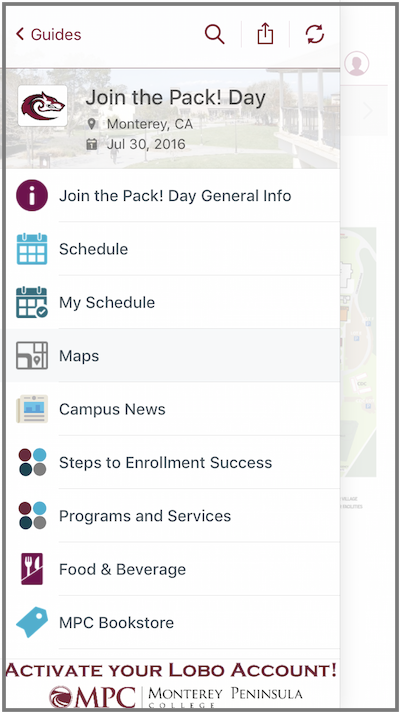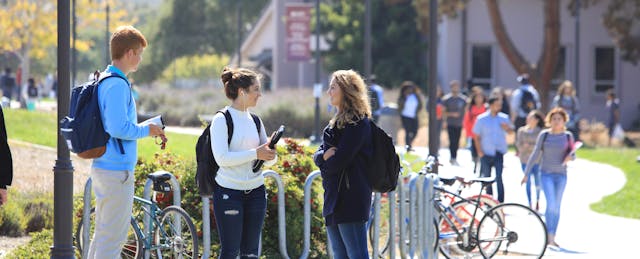Students cite the college visit as a top deciding factor in choosing a school. Yet schools of all sizes are struggling to meet demand for campus tours—and missing out on making that valuable first connection with a prospective student. With dwindling budgets and limited resources at higher ed institutions, mobile apps are filling the gaps.
That was the case for California’s Monterey Peninsula College (MPC). In her first year as Director of the Student Success and Support Program, LaKisha Bradley and one other colleague were the only staff available to give tours. “If it didn’t work with our schedules, we had to resort to handing out paper documents with the names of all the buildings on campus and a description of the programs offered,” she says. “We needed a better way to serve people who were interested in visiting the campus.”
Doing More with Less
LaKisha heard about the Guidebook mobile app platform, which could be used to create self-guided mobile tours. As someone without technical experience and minimal IT resources at her disposal, she was skeptical about creating a tour app on her own. It turned out to be much easier than she expected.
The tours app template took care of all of the heavy lifting. After that, LaKisha says, it was a simple matter of adding all of the detail from the paper, self-guided tour handout into the app and collaborating with other departments on what should be included. The student activities department, for example, wanted to be sure clubs were included.
The result was a mix of interactive and rich audio content—including photos of campus buildings, student stories, and directions—to guide students around campus, giving them an authentic feel for the college. LaKisha included descriptions of programs of study and student resources and an interactive campus map that highlights important landmarks, allowing visitors to easily find their way around.
Not only is the tour app dramatically more interactive than a sheet of paper, but it communicates to students the way they want to be reached—through their mobile devices. By supplementing in-person tours with a mobile tours app, colleges are able to reach more students without adding staff.
“For anybody not able to visit the school in person, like many of our out-of-state or international students, or for those we couldn’t serve due to schedules, being able to offer these mobile tours is wonderful,” says LaKisha. And for those students who do take a live tour, the app lets them revisit the campus virtually.
Around the same time that MPC put the mobile tours in place, it was also expanding its student ambassador program. These ambassadors are now benefiting from the app as well. “One recently came to me and said he really appreciates the app and that he even uses it as reference when he’s giving live tours,” shares LaKisha.

Fueling Campus-Wide Outreach
Reaching out to prospective students previously fell on the shoulders of individual program faculty and department heads. There was no uniform approach for recruiting. Now, MPC is actively seeking innovative ways to better promote the college. The introduction of mobile apps is part of that larger campus-wide outreach program.
Following the initial success of the mobile tour app, LaKisha and her team decided to create a separate virtual tour app for their annual Join the Pack! day, a recruiting event that attracts up to 200 people. Any update to the Join the Pack! app—such as a location change for one of the workshops—went live instantly, making it easy to communicate with everyone in the moment. While there was confusion about the location changes for people who didn’t use the event app, it proved incredibly helpful for those who did. “Everyone who downloaded it knew exactly where to go,” explains LaKisha.
Creating a virtual tour for the event also benefited the college, which was able to eliminate the cost of printed pamphlets and the inherent waste of all that paper.

Steps to Success
As LaKisha recognized, mobile has quickly shifted from a nice-to-have to a necessity for schools to effectively engage with students. But you don’t have to go big to be effective. Following the example of MPC, here are a few tips to help you get started:
- Start small. Adopting an app platform is a comparatively small risk, especially when you stack it up against custom app development. Start with a single, focused use case—like the mobile campus tour—to get comfortable with and prove the value of the technology. Then iterate and scale, as MPC did with the Join the Pack! app, when the college is ready.
- Don’t copy—complement. While MPC drew on existing content from their website—such as Admissions FAQs—they didn’t try to replicate it. Native mobile apps allow linking to any web page, so you can embed those pages in your tour where appropriate.
- Maximize device features. The built-in GPS on most smartphones is a major advantage, enabling you to extend the reach of admissions by pointing visitors in the right direction—directly from the phone. As adoption grows, you can also leverage the device’s built-in camera for photo sharing and push notifications to keep people informed about the latest updates—all capabilities built into native mobile apps like MPC’s.
- Share and expand. With app building platforms that take the technical skill out of building an app, any staff member can publish one without IT’s involvement. So don’t put the ownership with a single stakeholder; distribute app-creating responsibilities—and opportunities—across departments who can tap into mobile to meet their needs.
Mobile technology isn’t a replacement for one-on-one relationship building. Rather, mobile apps are a supplement—allowing better use of resources—as well as a catalyst, sparking new ways for mobile-savvy students to discover, interact and engage.



